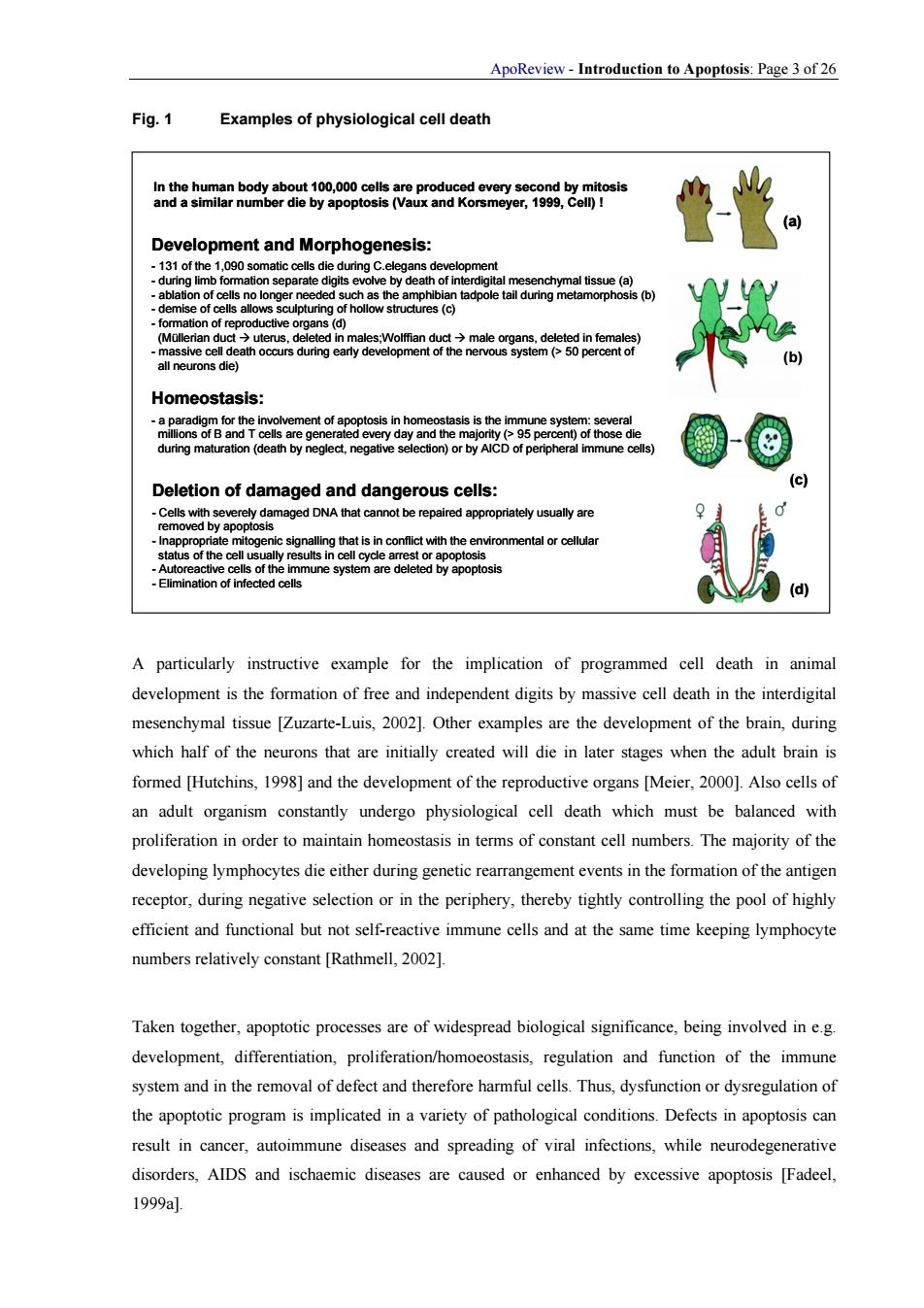正在加载图片...

ApoReview-Introduction to Apoptosis:Page3of26 Fig.1 Examples of physiological cell death hhehnmnbeat9apo0ceeroaidsmeye8ng.gost Development and Morphogenesis: all neurons di) Homeostasis: tasis ishen Deletion of damaged and dangerous cells: sualy are sig g that is in co ental or cellula ell of the A particularly instructive example for the implication of programmed cell death in animal development is the formation of free and independent digits by massive cell death in the interdigital mesenchymal tissue [Zuzarte-Luis,2002].Other examples are the development of the brain,during which half of the neurons that are initially created will die in later stages when the adult brain is formed [Hutchins,199]and the development of the reproductive organs [Meier,2000].Also cells of an adult organism constantly undergo physiological cell death which must be balanced with proliferation in order to maintain homeostasis in terms of constant cell numbers.The majority of the developing lymphocytes die either during genetic rearrangement events in the formation of the antigen receptor,during negative selection or in the periphery,thereby tightly controlling the pool of highly efficient and functional but not self-reactive immune cells and at the same time keeping lymphocyte numbers relatively constant [Rathmell.2002] Taken together,apoptotic processes are of widespread biological significance.being involved ing development,differentiation,proliferation/homocostasis,regulation and function of the immune system and in the removal of defect and therefore harmful cells.Thus,dysfunction or dysregulation of the apoptotic program is implicated in a varicty of pathological conditions.Defects in apoptosis can result in cancer,autoimmune diseases and spreading of viral infections,while ncurodegenerative disorders,AIDS and ischaemic diseases are caused or enhanced by excessive apoptosis [Fadeel. 1999aApoReview - Introduction to Apoptosis: Page 3 of 26 Fig. 1 Examples of physiological cell death Development and Morphogenesis: - 131 of the 1,090 somatic cells die during C.elegans development - during limb formation separate digits evolve by death of interdigital mesenchymal tissue (a) - ablation of cells no longer needed such as the amphibian tadpole tail during metamorphosis (b) - demise of cells allows sculpturing of hollow structures (c) - formation of reproductive organs (d) (Müllerian duct Æ uterus, deleted in males;Wolffian duct Æ male organs, deleted in females) - massive cell death occurs during early development of the nervous system (> 50 percent of all neurons die) In the human body about 100,000 cells are produced every second by mitosis and a similar number die by apoptosis (Vaux and Korsmeyer, 1999, Cell) ! Homeostasis: - a paradigm for the involvement of apoptosis in homeostasis is the immune system: several millions of B and T cells are generated every day and the majority (> 95 percent) of those die during maturation (death by neglect, negative selection) or by AICD of peripheral immune cells) Deletion of damaged and dangerous cells: - Cells with severely damaged DNA that cannot be repaired appropriately usually are removed by apoptosis - Inappropriate mitogenic signalling that is in conflict with the environmental or cellular status of the cell usually results in cell cycle arrest or apoptosis - Autoreactive cells of the immune system are deleted by apoptosis - Elimination of infected cells (a) (b) (c) (d) Development and Morphogenesis: - 131 of the 1,090 somatic cells die during C.elegans development - during limb formation separate digits evolve by death of interdigital mesenchymal tissue (a) - ablation of cells no longer needed such as the amphibian tadpole tail during metamorphosis (b) - demise of cells allows sculpturing of hollow structures (c) - formation of reproductive organs (d) (Müllerian duct Æ uterus, deleted in males;Wolffian duct Æ male organs, deleted in females) - massive cell death occurs during early development of the nervous system (> 50 percent of all neurons die) In the human body about 100,000 cells are produced every second by mitosis and a similar number die by apoptosis (Vaux and Korsmeyer, 1999, Cell) ! Homeostasis: - a paradigm for the involvement of apoptosis in homeostasis is the immune system: several millions of B and T cells are generated every day and the majority (> 95 percent) of those die during maturation (death by neglect, negative selection) or by AICD of peripheral immune cells) Deletion of damaged and dangerous cells: - Cells with severely damaged DNA that cannot be repaired appropriately usually are removed by apoptosis - Inappropriate mitogenic signalling that is in conflict with the environmental or cellular status of the cell usually results in cell cycle arrest or apoptosis - Autoreactive cells of the immune system are deleted by apoptosis - Elimination of infected cells (a) (b) (c) (d) A particularly instructive example for the implication of programmed cell death in animal development is the formation of free and independent digits by massive cell death in the interdigital mesenchymal tissue [Zuzarte-Luis, 2002]. Other examples are the development of the brain, during which half of the neurons that are initially created will die in later stages when the adult brain is formed [Hutchins, 1998] and the development of the reproductive organs [Meier, 2000]. Also cells of an adult organism constantly undergo physiological cell death which must be balanced with proliferation in order to maintain homeostasis in terms of constant cell numbers. The majority of the developing lymphocytes die either during genetic rearrangement events in the formation of the antigen receptor, during negative selection or in the periphery, thereby tightly controlling the pool of highly efficient and functional but not self-reactive immune cells and at the same time keeping lymphocyte numbers relatively constant [Rathmell, 2002]. Taken together, apoptotic processes are of widespread biological significance, being involved in e.g. development, differentiation, proliferation/homoeostasis, regulation and function of the immune system and in the removal of defect and therefore harmful cells. Thus, dysfunction or dysregulation of the apoptotic program is implicated in a variety of pathological conditions. Defects in apoptosis can result in cancer, autoimmune diseases and spreading of viral infections, while neurodegenerative disorders, AIDS and ischaemic diseases are caused or enhanced by excessive apoptosis [Fadeel, 1999a]